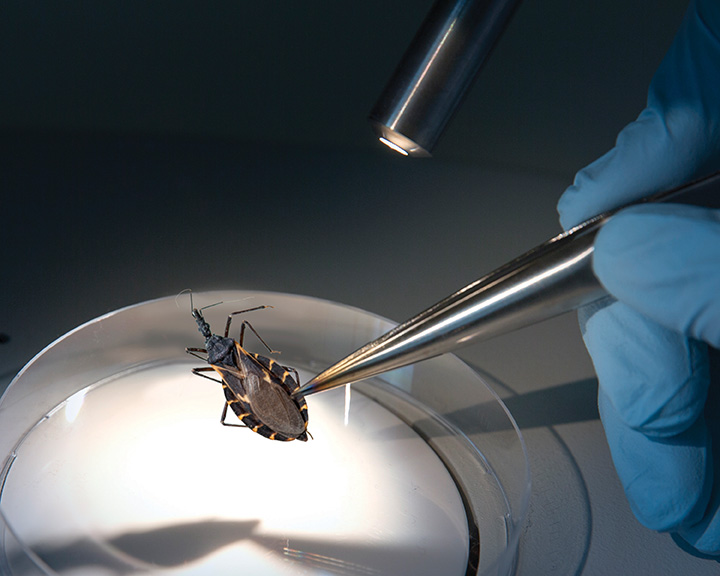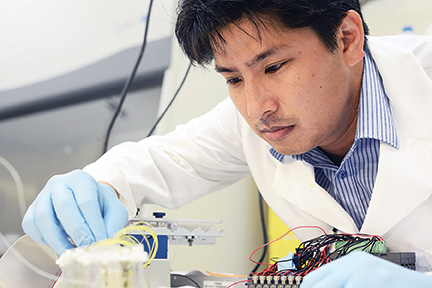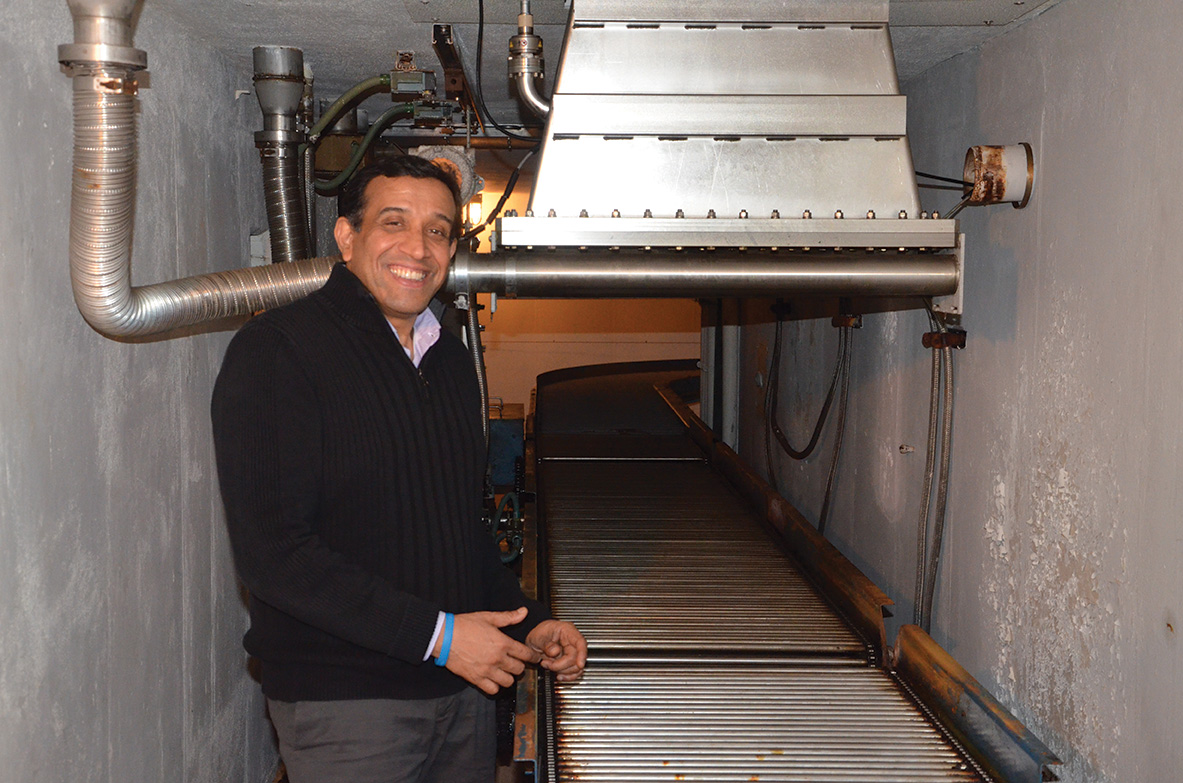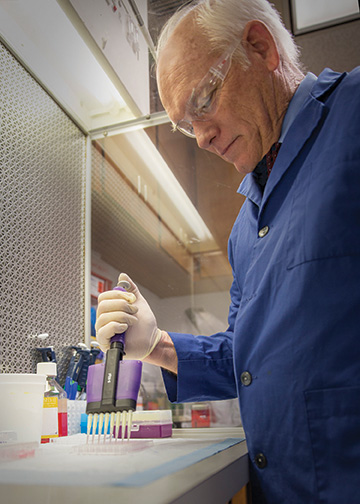A Grand Challenge: One Health research proposals funded
The One Health Initiative was formally started at Texas A&M University in 2011 to be a collaborative effort of multiple disciplines working locally, nationally, and globally to attain sustainable optimal health. The initiative is dedicated to the discovery, development, communication, and application of knowledge in a wide range of academic and professional fields, providing the highest quality undergraduate, graduate, and professional programs to prepare students to assume roles in leadership, responsibility, and service to society. It builds on the strength of the university and the state of Texas from discovery to application and commercialization allowing for the discovery, learning, and applied research to meet societal needs.

The One Health Grand Challenge increases opportunities for Texas A&M faculty members to plan and implement multidisciplinary, collaborative approaches improving the lives of all species-human and animal-by addressing health as well as the connections between health and both natural and manmade environments.
The One Health Campus Council, made up of faculty representatives from all colleges across campus, identified four major One Health research themes-Global Health & Security, Accessible & Affordable Quality Healthcare, Safe & Available Food and Water, and Chronic Diseases & Conditions-and implemented a plan to bring together teams to propose research initiatives under these themes.
“These proposals represent well what the One Health Grand Challenge at Texas A&M is all about,” said Dr. Eleanor M. Green, the Carl B. King Dean of Veterinary Medicine. “Facilitated by Dr. Michael Chaddock, assistant dean for One Health, investigators came together from across campus to form research teams dedicated to finding extraordinary solutions for diseases of importance to Texas and beyond. Equally impressive is the funding of this project, which was also a team approach. Dr. Glen Laine, vice president for research at Texas A&M, matched voluntary contributions from the involved colleges to fully fund this research challenge proposal.”
Global Health & Security

A Texas A&M team of researchers plans to approach research on Chagas disease from an ecological perspective. They will look at how environmental factors, such as climate and land cover, and socioeconomic factors, such as housing conditions, affect the distribution of the disease. As the disease is transmitted primarily by insects called kissing bugs, any factor that influences kissing bug abundance or behavior will also impact disease risk. For example, poor housing conditions allow kissing bugs to colonize the home and increase the opportunity for them to take a blood meal from a sleeping human. Furthermore, as the climate changes, the distribution of the kissing bugs can shift, which could lead to the emergence of Chagas disease in new areas of the United States.
Chagas disease, which affects approximately eight million people in the Americas, according to the United States Centers for Disease Control and Prevention, is caused by the parasite Trypanosoma cruzi and is spread by kissing bugs, which are prevalent across North, Central, and South America. Although once thought to be only a tropical disease, there is a current problem of canine Chagas disease in many regions of Texas that affects working dogs, such as military or border patrol, prized purebred breeding and show dogs, household pets, and stray dogs. In addition to the humans and dogs affected, the disease has been reported in South America in both cattle and pigs, and thus has the potential to threaten the economic stability of those who rely on livestock. Between 30 and 40 percent of those infected will develop life-threatening heart disease.
In addition to the cardiac complications, humans can also experience intestinal complications and even-especially in young children – meningoencephalitis, which is a life-threatening inflammation of the brain.
The team’s research proposal is a collaboration of faculty members in six Texas A&M colleges (the colleges of Agriculture & Life Sciences, Architecture, Geosciences, Science, and Veterinary Medicine & Biomedical Sciences, as well as the School of Public Health). Together, they have expertise in ecology, epidemiology, population genetics, parasitology, community health, border health, medical anthropology, medical and veterinary entomology, land and economic development and planning, Latin American studies, and spatial analysis.
“Zoonotic diseases are the ultimate One Health challenge because of the complex interactions among humans, wildlife, domestic animals, vectors, and pathogens within shared environments,” said Dr. Sarah Hamer, an assistant professor in the College of Veterinary Medicine & Biomedical Sciences (CVM) and the principal investigator on the project. “We plan for our research and outreach on Chagas disease to serve as ‘proof of principle,’ and that our One Health approach will be extended to tackle other vector-borne zoonotic disease systems in the future. We are in a great place for Texas A&M University to be a leader in multidisciplinary vector-borne disease research.”
The team plans a three-pronged approach to their research in South Texas. First, they will trap kissing bugs; collect wildlife, domestic animal, and human blood samples; and assess the socioeconomic environment. Then, they will process samples in the laboratory to sequence DNA and determine the population genetics of both the parasites and the kissing bugs that transmit them. Finally, they will use that information to map the disease over time and space, taking into account the relationships between environmental, climatic, and demographic factors that influence spread and severity of disease. This map will then serve as a basis for future research, as it can help identify risk factors and evaluate intervention strategies.
Although there is a recent increase in awareness of Chagas disease in Texas, researchers believe Chagas disease has existed in the Southern United States for a long time. In fact, mummified remains of humans from Texas and South America who died more than 1,150 years ago have evidence of Chagas disease.
“This devastating disease is one of several neglected tropical diseases that can increase the poverty in already disadvantaged regions, as it can have impacts on child development and worker productivity,” said Chaddock. “As an under-diagnosed, under-reported disease with poorly understood risk factors, this type of research is desperately needed.”
Accessible & Affordable Quality Healthcare

A research initiative led by Dr. Arum Han from the Department of Electrical and Computer Engineering has faculty from the CVM, Dwight Look College of Engineering, Texas A&M Health Science Center, and Texas A&M Agri-Life. The title of their initiative is “Miniature Tissues and Organs for Detection and Prevention of Diseases,” which focuses on development of next-generation biologics through microphysiological systems.
“I believe that multidisciplinary collaboration is key in addressing challenges in this new One Health paradigm,” said Han, “and I hope that engineering technologies can make significant contributions towards solving these grand challenges of societal importance.”
The vision of this Microphysiological Systems Initiative is to create a world where human, animal, and plant diseases can be readily detected, disease mechanisms can be accurately and quickly deciphered, emerging threats can be predicted, and new therapeutics and vaccines can be rapidly developed, all at low cost, thus ultimately providing accessible and affordable healthcare.
“We have a tremendous amount of expertise and human capital at Texas A&M, and we are ideally suited to address many of society’s greatest health challenges,” said Dr. M. Katherine Banks, vice chancellor and dean of engineering. “Innovation thrives when we bring great scholars together, and it is exciting to imagine the possible advances that will come from their multidisciplinary approach to problem solving.”
The technological innovations at the core of this initiative are in developing in-vitro microsystems that closely mimic the physiology of whole organisms, and in developing lab-on-a-chip systems that are high throughput, accurate, flexible, and low cost. Systems that mimic (or reproduce) human physiological systems (for example, organ-on-a-chip) aim to overcome the limitations of currently used in-vitro models and animal models. Lab-on-a-chip systems can accelerate assays and significantly lower costs. Combined together, the team is hoping to provide a new paradigm for improving our capabilities to provide accessible and affordable healthcare. The initial focus areas of this initiative will be neurodegenerative diseases, immune systems, and the human microbiome; however, the team is hoping that the developed systems and their applications can be more broadly expanded and adapted to solving other health problems of high societal importance.
“The proposal submitted by Dr. Han and his team of investigators holds great promise in radically changing how we examine organ systems and perform diagnostics in multiple species,” Chaddock said. “Interdisciplinary approaches such as this-that advance knowledge, that will improve global health-are at the very core of the definition of One Health.”
Safe & Available Food and Water

As an established leader in electron beam technology, Dr. Suresh Pillai, director of the National Center for Electron Beam Research within the Texas A&M College of Agriculture & Life Sciences (COALS) Department of Poultry Science, along with an interdisciplinary team of investigators from eight Texas A&M colleges as well as Texas A&M AgriLife Extension, the Texas A&M University System Office of Technology Commercialization, the Texas A&M Institute of Biosciences and Technology, the National Center for Therapeutics Manufacturing (NCTM), the Texas A&M Institute for Genomic Medicine, and the Texas A&M Institute for Preclinical Studies, were recently awarded funding to pursue novel applications for this innovative technology as it applies to ensuring safe and available food and water.
“The faculty in our college are well positioned to facilitate progress at Texas A&M in this area,” said Dr. Bill Dugas, acting vice chancellor for agriculture and life sciences and COALS acting dean.
The focus of this initiative is to develop novel uses for the one-of-a-kind electron beam technology aimed at eradicating water-borne, food-borne, and feed-borne infectious diseases in humans and animals through developing new vaccines and other therapeutics; ensuring global food supply security through new packaging, treatment, and processing methods; and exploring the use of this technology in improving food and water quality.
“This technology uses commercial electricity, which is transformed by stripping off electrons,” explained Pillai. “What makes it a truly paradigm-shifting technology is that it creates both reduction and oxidation processes simultaneously without the addition of chemicals. The frequency levels of electron beam are adjustable, which allows us to use it at the lower end for killing insects and pests, at the mid range for treating food and water for dangerous pathogens, and then at the higher end to create memory shape plastics that may be used in medical applications.”
The proposed project in electron beam technology leverages Texas A&M’s unequaled strength characterized by the combination of technological capabilities and expertise. This unique collaborative effort will initiate strategic partnerships between academia, private industry, non-governmental organizations, entrepreneurs, global financing institutions, eBeam equipment suppliers, and national and international regulatory agencies that will take advantage of the technological potential of this platform in healing, cleaning, feeding, and shaping this world in ways not seen before.
“The proposal submitted by Dr. Pillai and this team of investigators holds great promise in creating the next generation of killed vaccines, developing new methods for cleaning the environment and improving the sustainability of our natural resources, and protecting the global food supply from massive loss,” said Chaddock.
Chronic Diseases & Conditions

Enhancing the health and well-being of animals and humans through the alleviation of chronic illnesses and conditions is the goal of an innovative project recently awarded funding through the competitive One Health Grand Challenge proposal process. The project’s team will approach this objective by addressing the adverse physical, societal, and economic effects of stressful chronic conditions, including metabolic dysregulation and obesity.
The interdisciplinary team includes faculty from seven Texas A&M colleges (COALS, the CVM, and the colleges of Education and Human Development, Engineering, Liberal Arts, Medicine, and Pharmacy) as well as Texas A&M AgriLife Research.
“The faculty in our college have the training, skills, and abilities to integrate the environment, animal, and human aspects of a problem to solve the complex but very important grand challenges facing our society, such as improving our health,” said Dugas.
The focus of this initiative is to further develop the understanding of genetic and environmental factors, including stress, that can disrupt metabolic functions in humans and animals, which may lead to a variety of chronic conditions such as cardiovascular disease, obesity, and diabetes, and a reduction in productivity.
“There are numerous undesirable conditions that can arise when an animal or person cannot maintain a healthy balance,” said Dr. Tom Welsh, the project’s primary investigator and a professor in COALS with a joint appointment at the CVM. “Our approach includes four separate projects, each of which will investigate environmental and genetic factors influencing the regulation of metabolic health. By learning how to manage these factors, we will be able to reduce susceptibility to chronic disease in humans and animals and also reduce stress on animals that affects their productivity.”
Two pilot projects will focus on behavior and stress related to metabolism. These will include the investigation of prenatal stress on calves and, separately, will examine epigenetic changes in human patients diagnosed with post-traumatic stress disorder. Two additional projects include work to determine environmental factors that influence metabolism, as well as the role that microbes in the body (or the microbiome) play in metabolic regulation.
“The proposal submitted by Dr. Welsh and this team of investigators holds great promise in creating new understanding of the relationship between the environment, genetics, stress, and the cascade of chronic diseases that result from stress on the metabolic system,” Chaddock said.
More information about these One Health Grand Challenge proposals, including videos about each, may be found online.


